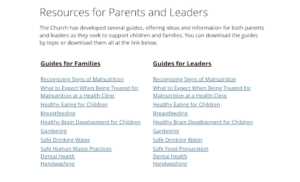Followers of Jesus Christ are not unfamiliar with the frequent admonition from Him to take care of the less fortunate. As President Dallin H. Oaks has said, “Giving to those in need is a principle in all Abrahamic religions.” Indeed, for members of The Church of Jesus Christ of Latter-day Saints, the words of King Benjamin are recited almost anthemically, “… when ye are in the service of your fellow beings, ye are only in the service of your God.”
Caring for those in need is a foundational principle of the gospel of Jesus Christ. From the beginning of the modern church, the Lord has clearly created a pattern of priority for the leadership in these efforts: “And they shall look to the poor and the needy, and administer to their relief that they shall not suffer.” In the effort to remain accountable and transparent about these priorities, members are able to see yearly reports and caring summaries to see exactly how leadership is highlighting this mission as disciples of Christ.
The 2023 Caring Summary focuses on the efforts of the Church and its members, which include $1.36 billion in expenditures, 6.2 million hours volunteered, 4,119 humanitarian projects, and 191 countries and territories served. These efforts reflect the mission and purpose of the Church’s welfare program. As President Eyring has previously stated:
Great temporal needs of the children of Heavenly Father have come again in our time as they have and as they will in all times. The principles at the foundation of the Church welfare program are not for only one time or one place. They are for all times and all places.
One need only look at previous summaries to see that year after year, the Church and its members continue to give more in terms of time, funds, and services. These projects, services, and funds ongoingly provide for healthcare, education, disaster relief, self-reliance education, refugees, housing, mental healthcare, and so much more. Caring for those in need is a foundational principle of the gospel of Jesus Christ.
Of particular note have been the efforts headed by the General Relief Society Presidency to combat hunger and malnutrition. The World Food Program estimates that every year, 3 million children die from hunger-related causes. In response to this sobering reality, the President of the General Relief Society, Camille N. Johnson, has said: “No humanitarian effort is more foundational to Christ’s Church than feeding the hungry.”
To help reach as many families as possible, the General Relief Society Presidency and board have made efforts over the years to partner with other organizations to increase overall positive impact, including CARE, Catholic Relief Services, The Hunger Project, The World Food Program, and UNICEF’s No Time to Waste Initiative.
The General Relief Society Presidency and board seem to be uniquely qualified and situated to head the initiative. The Church highlights on its website the needs of underserved and underprivileged women and children in particular:
Many children around the world suffer from the effects of malnutrition. Healthy nutrition is essential to proper brain, body, and immune system development, especially from the time of conception to ages 2-3. If a child does not receive the proper nutrition during this time, the child’s brain and body will not develop as they should.
Additionally, they are focused on helping “children have access to comprehensive nutrition care, including nutritious foods, safe drinking water, supported access to local clinical services, and other factors.” The photo below shows the resources listed on the Church’s website, with guides and information on helping local leadership and families become educated on the various aspects of malnutrition.

Evidenced by this snapshot, they have been incredibly thorough in not only recognizing and supplying guides for the specific needs of the people affected by malnutrition but also creating a way for families and leaders to be proactive in their efforts to prevent such suffering in the first place.
As I have pondered this goal further, there are, perhaps, a few other questions that may be worth exploring. The effort to eliminate malnutrition within the membership of the Church is quite amazing; however, why do they emphasize eliminating it within membership only rather than eliminating it generally? Are they reverting their efforts to focus only on the members? And what might this mean for humanitarian efforts moving forward? The Church is in a unique position with its carefully laid infrastructure.
Rather, the Church is in a unique position with its carefully laid infrastructure to be able to identify members in need more readily than many other organizations. The Church is designed to, ideally, look after “the one.” If we work down the ladder, Stake Presidents oversee Bishops who oversee the Elder’s Quorum and Relief Society who both oversee ministering efforts to oversee individuals and families, often both within and outside of the Church. While this is not the structure in all places depending on membership density, this example gives an idea of how they have focused on creating a system that allows for the greatest opportunity to know the needs of each member and supply them with the resources or help required.
With the right training and access to resources, it is not unfathomable that the Church would indeed be able to end malnutrition within the membership because of this infrastructure. This is, perhaps, what makes this particular effort and goal of the General Relief Society so amazing—we can reasonably accomplish this! That is not to say that it is without great effort or that there will be no difficulties to overcome. It is to say that there is a viable path forward to end malnutrition within the vast membership of the Church on a worldwide scale in a way that has never been done before. Further, it is entirely achievable without diminishing efforts in other areas to eliminate suffering beyond membership.

















